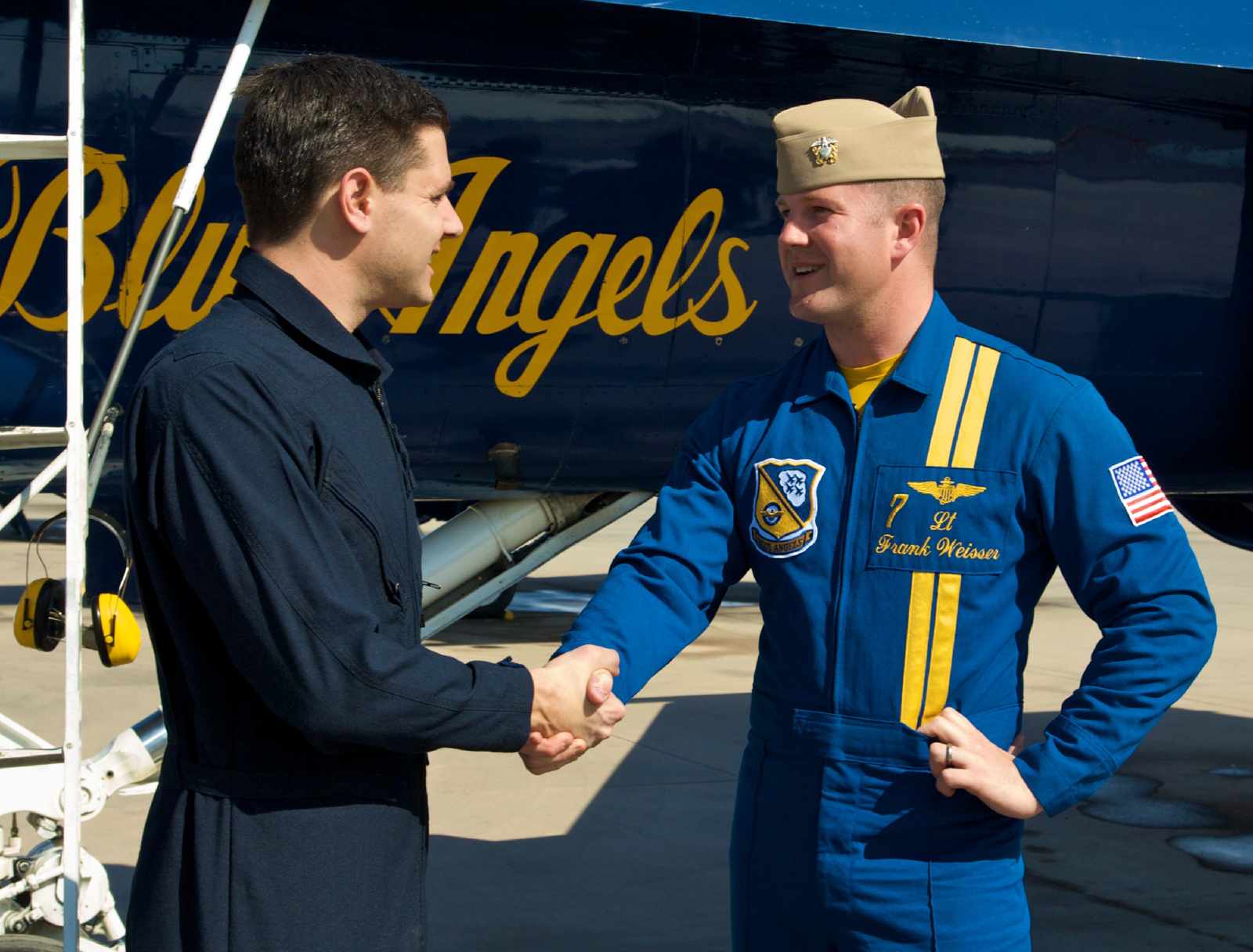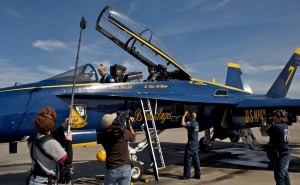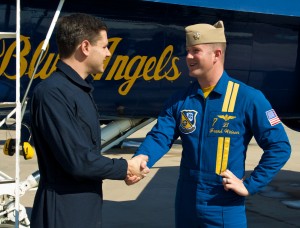
Brian J. Terwilliger thanks Blue Angel #7, Lt. Frank Weisser, for the exhilarating experience. The flight was an introduction to the F/A-18 Hornet’s capabilities.
By Henry M. Holden
As a young boy, Brian J. Terwilliger built and flew model airplanes and had aviation posters on his bedroom walls. He saw his first air show when he was 13, and remembers the highlight.
“The Blue Angels performed,” he recalled. “My dad took a picture of me getting a Blue Angels’ autograph on a poster, and I still have it today, rolled up in mint condition.”
Terwilliger said the air show immediately made a lifelong impression upon him.
“I think that’s what air shows are all about: showing the excitement of aviation and inspiring people of all ages,” he said. “The Blue Angels certainly made a significant impact on me.”
That air show would be the first of many Terwilliger would attend. His passion for aviation would also lead him to become a private pilot and later, to produce and direct “One Six Right,” a documentary celebrating the unsung hero of aviation: the local airport. The film traces the rich history and struggles of Southern California’s Van Nuys Airport.
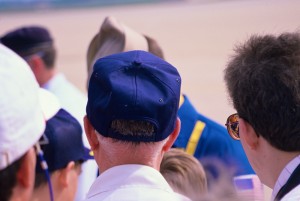
Young Brian J. Terwilliger’s brown hair and blue baseball cap is all you can see of him as he awaits an autograph from the Blue Angels.
Recently, Terwilliger was able to do more than just watch his childhood heroes perform. He actually got to fly with the Blue Angels, the Navy’s flight demonstration squadron.
He encountered the current Blue Angels team last December at the annual International Convention of Air Shows in Las Vegas. Team members were there to receive the Sword of Excellence award from ICAS, becoming the first organization ever to receive such an honor.
When Terwilliger started talking to the pilots, he was flattered to learn that some of them had actually seen “One Six Right.” During the conversation, he couldn’t resist asking what it would take to fly with them. They shared some of the details and then suggested that with his film experience, he would make a perfect ambassador for them.
Still, in the weeks that passed after the event, he decided not to tell many people that he “might” have an opportunity to fly with the Blue Angels. He knew that it wouldn’t be a slam-dunk, since the entire team had to approve it. Eventually, he received a formal invitation.

Blue Angel #5, Lee Grawn, is autographing 13-year-old Brian J. Terwilliger’s print. Terwilliger kept the print in mint condition until his next meeting with the Blue Angels in 2008, nearly 20 years later.
According to Lt. Frank Weisser, Blue Angel #7, there were a few reasons why they extended an invite to Terwilliger.
“When you meet someone, it’s easy to tell if he’s competent and proficient,” Weisser said. “It didn’t take long to see Brian was a squared-away guy, heading in the right direction. It was interesting to see what he’d already accomplished as a young producer. He’s achieved excellence to such an extent.”
Terwilliger and the Blue Angels decided on a date in February for the VIP flight; however, Terwilliger had to get a medical exam prior to the flight.
“My doctor had to affirm that I didn’t have any predisposition to getting airsick, that I could clear my ears and that I don’t have any heart issues,” said Terwilliger.
Upon arrival at the El Centro Naval Air Facility, where the Blue Angels do their winter training, he took part in a briefing about what to expect during his flight.
“They talked me through the maneuvers we were going to do, the forces I’d feel and how to breathe through the G-forces without passing out,” Terwilliger said. “They gave me a complete rundown on the instruments. They wanted me to get the most out of the experience by understanding what the jet is showing me—especially the Mach meter, airspeed and altitude, because during the flight, these would be very interesting to watch.”
“We have 1,000 gallons of gas, and it’s all yours,” Weisser told Terwilliger. “Now let’s go up there and have some fun.”
Weisser would be taking Terwilliger on a thrill ride of a lifetime in the F/A-18 Hornet on a “VIP profile.”
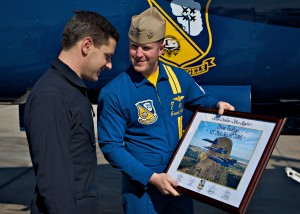
Lt. Weisser presents a signed and dated photo given to all VIP flight recipients. Brian Terwilliger said it was the most thrilling ride he ever had.
“While I was being strapped in, they showed me everything I could touch as well as the things I couldn’t,” he said. “I needed to arm my ejection seat after we started taxiing.”
On takeoff, Weisser stood on the brakes and went to full military power—the most power the airplane can generate without the use of afterburners. On the takeoff roll, he powered the aircraft up to 150 knots and then plugged in the afterburners, generating 50 percent more power (a total of 32,000 pounds of thrust). When he had a flying speed of 300 knots, Weisser planted the stick in his lap, taking the jet nearly vertical. Terwilliger felt the plane accelerate as he pulled just over 6 G’s.
The ride would have been exciting enough, but Terwilliger was hoping for one special moment.
“I’ve been very fortunate to have flown in many types of airplanes, including aerobatic planes and antiques, but I’ve never been in a plane that was capable of flying faster than the speed of sound,” he said.

Brian Terwilliger sits in front of the Blue Angels print he saved for many years. He got two of the pilot’s autographs in the 1980s and never imagined he would fly with them almost 20 years later.
Although the pilots can’t break the sound barrier during air shows, because they’re typically in civilian areas, they can do it at El Centro, since the military base is connected to a military operating area. However, it’s not guaranteed, and controlling authorities initially denied permission due to other activities in the supersonic range.
“Lt. Weisser asked the controllers to get back to us if the range opened up,” Terwilliger recalled. “He called twice more, and after a long pause on the third attempt, the voice said, ‘I can get you in right now for 10 minutes.’ I couldn’t believe we were actually going to do it!”
Weisser started with a high alpha maneuver, with the nose pointed up and the jet almost to the edge of a stall at 125 knots (.20 mach). When Terwilliger was all set, he plugged in the afterburners again and brought the nose down about a degree relative to the horizon, and they accelerated to supersonic—650 knots (about 747 mph)—in less than 30 seconds. Terwilliger watched as the Mach meter moved from .20, then a few seconds later passed .50, and then a few seconds later passed .92, .93 and .95. Then suddenly, it passed 1.01 Mach.
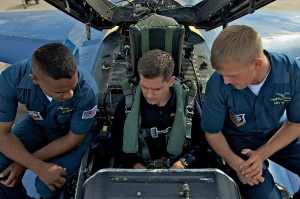
Brian Terwilliger gets an in-cockpit briefing on what he can and can’t touch as well as a complete rundown on the instruments. He was responsible for disarming his ejection seat after they landed.
“We went from a couple thousand feet down to 500 feet above ground level,” he said. “We were going so fast and were so low, there was such a ground rush. Except for a little bump exiting the sound barrier, it was a relatively benign feeling; there was no noise or buffeting in the jet as we went through the barrier. It was a once in a lifetime moment!”
Weisser and Terwilliger then took off towards Star Wars Canyon, northwest of Yuma, Ariz., where portions of episodes one and four of “Star Wars” were filmed.
“I gave Brian an example of a low-level attack,” Weisser said. “It’s pretty unique for people to fly 200 feet off the deck at 500 knots. The purpose of this maneuver is to get in below the radar and maintain a speed where you’ll have the energy to get away if a shoulder-fired missile is fired at you.”
Terwilliger recounted jagged terrain in the mountain passes and zigzagging below the peaks of the mountains.
“I thought we were going to hit a mountain wall several times,” he said. “Lt. Weisser made it look easy, but there were hundreds of hours of training behind his skill. It was almost as if I was in a video game!”
Terwilliger later took the stick for about 10 minutes and did some turns, loops and rolls, working the throttles and afterburners. He then flew the jet back towards base, making the necessary heading and altitude changes with Weisser’s direction.
While being debriefed from the flight, back at the El Centro Naval Air Facility, Terwilliger unveiled the nearly 20-year old autographed print that he had cherished since childhood. He had Lt. Weisser sign and date it, commemorating the special day.
“Now I think it’s time to frame it,” said Terwilliger.
Weisser expressed his appreciation that Terwilliger had kept the print for so long.
“As Blue Angels, our goal is to inspire young boys and girls, and we do that with our airplanes and our interactions with them after the show,” Weisser said. “That he’d hold on to that print for so long says a lot.”
As for his good fortune of getting a ride with the Blue Angels, Terwilliger philosophized that luck is “preparation meeting opportunity.”
“To them, I was just another passionate kid that never grew up,” he said. “My preparation had been a strong dedication to making ‘One Six Right,’ and when I recently met the current pilots on the team, I realized the opportunity. I feel like one of the luckiest guys—my childhood dream came true.”

Blue Angel #7, an F/A-18 Hornet, goes vertical on takeoff, soaring into the sky with full afterburners. Brian Terwilliger pulled more than 6 G’s on takeoff.











